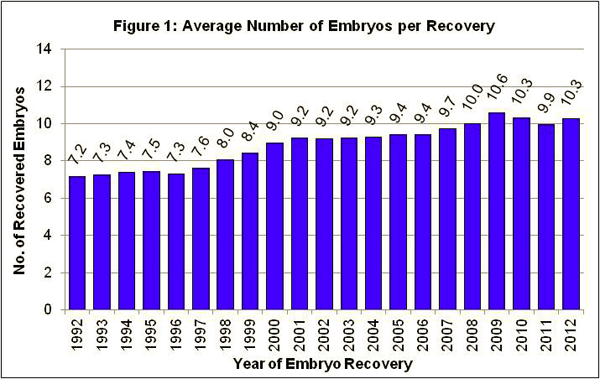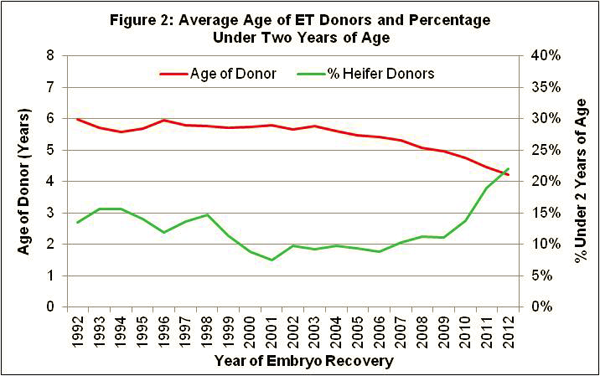Veterinarian practitioners offering embryo transfer (ET) services in Canada are required to report specific information pertaining to each embryo collection when at least one viable embryo is retrieved. The national breed association, such as Holstein Canada, therefore receives details relative to each ET flush including the donor animal, insemination date, embryo collection date and the number of viable embryos recovered. In addition, specific details are provided for each recovered embryo including its unique identification number, measures of embryo quality, whether it was regular or manipulated, and ownership. At the time any embryo is transplanted, either fresh or after having been frozen, more data is required to link it to the resulting calf, including the date of transplantation as well as the identification of the recipient and the embryo
used. Given the recent surge in interest towards ET due to the arrival of genomics as well as other advancements such as in-vitro fertilization (IVF), Canadian Dairy Network (CDN) conducted an analysis of all embryo transfer data available from Holstein Canada for collections during the past 20 years.
Trends in Embryo Transfer Activity
In the Holstein breed, over 146,000 embryo transfers with at least one recovered viable embryo were reported to Holstein Canada during the past twenty years and these involved nearly 55,000 different donors (≈2.7 flushes per donor). In terms of ET collections per year, a significant growth has been realised. In the 1990’s the number of flushes per year varied from approximately 4,000 to 6,500. For the five years from 2000 to 2004, this number surpassed 7,000 every year with 2002 reaching nearly 8,200. Since 2005, however, new heights have been reached with every year surpassing 8,000 embryo transfers, peaking over 8,500 in 2010. In terms of the number of different ET donor cows within year, the total has ranged from approximately 5,000 to 5,500 per year during the past decade.

Figure 1 plots the average number of viable embryos recovered for ET flushes from 1992 to 2012. A steady positive trend has been observed from an average of 7.2 to 7.6 embryos per flush for the period from 1992 to 1997 to one that attains 10 or more embryos per flush since 2008. Based on associated data related to embryo transplantation, approximately 90% of all embryos collected have traditionally been used and implanted into a recipient.
Age of Embryo Transfer Donors

Using the same ET data from Holstein Canada for flushes during the past twenty years, Figure 2 shows the trend in the average age of the donors as well as the proportion that were heifers under two years of age. In this plot the trend towards younger ET donors is evident with the average age fluctuating between 5.7 and 6 years (68-72 months) prior to 2004. Since that time, however, the age of ET donors in Canada has steadily decreased to 4.2 years (51 months) of age in 2012.
Associated with the decreasing trend in the average age of ET donors is the increasing popularity of flushing heifers under two years of age (Figure 2). Prior to 2000, roughly 15% of ET donors were under two years of age but this figure dropped to below 10% level from 2000 to 2006. Since 2009, however, the trend of using ET on heifers has rapidly increased to reach 19% for 2011 and 22% for 2012. It is probable that the August 2009 arrival of official genomic evaluations for Holsteins in Canada has been a major factor contributing to this recent trend.
Summary
Embryo transfer (ET) is a technology that has been available for decades. Its main aim is to provide an opportunity to produce more progeny from the best animals in a dairy herd. In general, producers place very little intensity on selection decisions when determining which cows and breeding heifers will be parents of the next generation of replacement calves. Embryo transfer is an important tool to alter this tendency and increase the rate of genetic progress in the herd. In Canada, over 8,000 ET flushes are conducted annually involving over 5,000 Holstein donors each year. Based on ET collections with at least one viable embryo, an average of more than 10 embryos per flush has been achieved in recent years. In addition, the average age of ET donors has steadily dropped during the past decade to reach 4.2 years in 2012, which is partially explained by the increasing trend towards heifer flushing which reached 22% last year.
Author: Brian Van Doormaal, CDN
Date: January 2013









